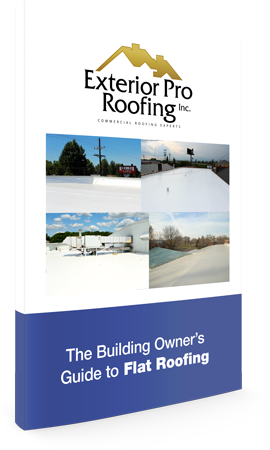You will have to explore all options and choose the best preforming and most cost effective solution based on your specific flat roofing situation.
1. Add Roof Drains
Flat roofs that pond water due to insufficient drainage can be corrected by adding either a roof drain and / or by adding through the wall scuppers that funnel water to a downspout and off the roof. In both instances location is everything.
 Adding a roof drain will consist of opening up the existing roof down to the deck and then coring a hole through the deck in order to set the new drain assembly. A commercial plumber or pipe fitter will then connect drain lines from the new drain assembly to an existing drain. A Commercial roofing contractor will then work to tie in the existing flat roofing system into the new drain assemble and ensure it’s water tight. It sounds straight forward and easy enough and sometimes it is but there are several factors that can influence the function and cost of adding a roof drain. Consider the type and age of existing roofing material and the ability to tie in to it, the number of layers of existing flat roofing already in place, the type of deck material to be cut, the finished ceiling height and room for new drain lines, and the distance the new drain will be away from the existing drain lines.
Adding a roof drain will consist of opening up the existing roof down to the deck and then coring a hole through the deck in order to set the new drain assembly. A commercial plumber or pipe fitter will then connect drain lines from the new drain assembly to an existing drain. A Commercial roofing contractor will then work to tie in the existing flat roofing system into the new drain assemble and ensure it’s water tight. It sounds straight forward and easy enough and sometimes it is but there are several factors that can influence the function and cost of adding a roof drain. Consider the type and age of existing roofing material and the ability to tie in to it, the number of layers of existing flat roofing already in place, the type of deck material to be cut, the finished ceiling height and room for new drain lines, and the distance the new drain will be away from the existing drain lines.
Building owners and faculties managers should consult with both a roofing contractor and a commercial plumber before making a final decision about adding a roof drain.
2. Using Tapered Roof Insulation
 The second option that building owners have to eliminate ponding water from their flat roof is to use tapered roof to better direct ponding water to existing roof drainage such as internal drains, guttering, or through the wall scuppers. Tapered roof insulation is made at an angle so it can be used to create “fall”. Most tapered roofing insulation slopes at 1/4 inch per ft and come in 4’ x 4’ 4’ boards that can be cut and fit to create almost any shape necessary to move water towards drainage. While tapered insulation board not the least expensive type of flat roof insulation, it can be very effective at eliminating ponding water. The benefits include not having to core the roof’s deck and no drain lines to plumb in.
The second option that building owners have to eliminate ponding water from their flat roof is to use tapered roof to better direct ponding water to existing roof drainage such as internal drains, guttering, or through the wall scuppers. Tapered roof insulation is made at an angle so it can be used to create “fall”. Most tapered roofing insulation slopes at 1/4 inch per ft and come in 4’ x 4’ 4’ boards that can be cut and fit to create almost any shape necessary to move water towards drainage. While tapered insulation board not the least expensive type of flat roof insulation, it can be very effective at eliminating ponding water. The benefits include not having to core the roof’s deck and no drain lines to plumb in.
3. Choose The right Membrane
If adding a roof drain isn't feasible at your building and tapered roof insulation is out of your budget you may find that have a flat roofing membrane installed that can handle ponding water is the best solution. Many PVC membranes on the market today are engineered to withstand ponding water. These membrane typically do not rely on glue or adhesives and have hot air welded seams that are completely water tight. Ponding water has very little affect if any on these types of PVC membranes and they can be used successfully buildings who’s ponding water problems range from mild all the way to sever year round standing water.







